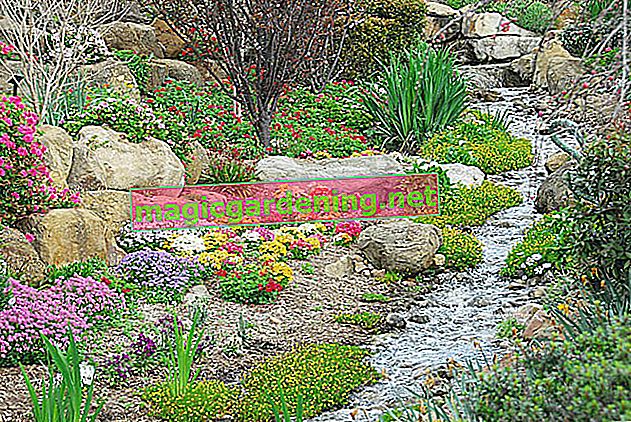
Plant sea lavender properly
Limonium that has been bought or prepared by hand would like to go into the ground from the beginning of May. So that the mighty taproot can spread quickly there, the lean, sandy-loamy soil in the sunny location is loosened up and weeded. Create a spacious planting pit at a distance of 35-40 cm from the neighboring beds. Clay-concrete earth is enriched with sand or fine grit on this occasion. (12.80 € at Amazon *) Do not plant the potted sea lavender deeper than it was cultivated in the nursery pot.
Continue reading
also read
- Plant sea lavender in your own garden
- The optimal care for the sea lavender
- The sea lavender: hardy in the garden?
Care tips
The need for care of sea lavender is at the maximum level immediately after planting, and later tends to zero. Since young limoniums move into the garden with a fairly high water requirement, they receive frequent visits with the watering can in the first few weeks. In the further course the rain takes over this work. The entire care program at a glance:
- Only water sea lavender in summer drought
- Apply starter fertilization in May in poor soil
- Alternatively, work in some compost every 30 days from May to August
- Repeatedly clean withered flowers
- Cut back close to the ground in autumn
- In case of winter drought, water a little on frost-free days
In winter gray regions, cover the planting site with brushwood or leaves to protect the root ball from excessive moisture. If Limonium thrives in the pot, place the container in a frost-free room throughout the winter and water it from time to time so that the root ball does not dry out.
Continue reading
Which location is suitable?
A full sun location is entirely to the taste of Limonium species. The sun worshipers do not let up, even during summer heat waves. Thanks to their stability, sea lavenders keep their upright posture even when a strong wind blows. This floral power unfolds in lean, chalky and sandy-dry soil.
The correct planting distance
The clump-like and bushy, spreading habit of sea lavender requires an appropriate planting distance of 35 to 40 cm. Compact species, such as North African sea lavender, come into their own at a distance of 30 cm from their neighbors.
What soil does the plant need?
Beach lavender not only provides the most beautiful dried flowers for your bouquets and arrangements. At the same time, the frugal perennial functions as a problem solver for locations with poor, sandy-dry soil. In addition, the soil for sea lavender can be chalky, as is the case in gravel beds or rock gardens. In the bucket, limonium thrives in common potting soil, which is enriched with sand and rock flour (€ 14.95 at Amazon *).
When is the flowering time?
The plant family gives us magnificent species and different flowering times. While the popular broad-leaved sea lavender spreads its flower clouds from May to July, the steppe veil sea lavender is just getting started for a blooming period from July to August. The flower festival is topped by the winged sea lavender, which blooms continuously from May to September.
Cut sea lavender properly
The fragrant inflorescences on wiry stems above the leathery to coarse leaves qualify sea lavender as a premium supplier for dried flowers. Therefore, during the flowering period, the perennial is cut for this purpose exactly when the flowers have just opened. If you want to enjoy the maritime flair all summer long, cut out dead flowers regularly. In autumn, cut the entire perennial to just above the ground and spread a layer of leaves or brushwood over it.
Watering sea lavender
Once a sea lavender is firmly rooted in the bed, the additional water supply takes a back seat. In the Central European climate, the perennial is content with natural rainfall. Meanwhile, if the leaves hang limply, sea lavender signals the need for watering. This exceptional case can occur during summer drought periods. In pot culture, the substrate dries out faster. Check the moisture content with your finger every few days in order to water when the surface of the earth is dry.
Fertilize beach lavender properly
Last but not least, sea lavender demonstrates its puristic character in terms of nutrient supply. A one-time start fertilization with complete fertilizer in May covers the energy requirement. In the near-natural garden, we recommend adding compost with horn shavings (€ 6.39 at Amazon *) every 30 days from May to August. If a sea lavender is in the bucket, pamper the perennial every 4 weeks from May to August with a liquid fertilizer for flowering plants.
Overwinter
The majority of Limonium species are hardy, so that they thrive in our gardens for several years. It is less freezing frost, from which sea lavender should be protected, because winter permanent wetness. We therefore recommend spreading a layer of brushwood or leaves after sea lavender has been cut back in autumn. Cut back potted plants close to the ground and move them to frost-free winter quarters.
Propagate sea lavender
The uncomplicated cultivation of sea lavender continues seamlessly with its reproduction. The following two approaches have worked well in the gardening hobby.
sowing
- Fill small pots with peat sand in February / March
- Sow 2-3 seeds at a time and sieve in three times the seed strength
- Moisten with a fine shower head, put a plastic bag over it and place it at the window
At 15-18 degrees Celsius, germination begins within 12-20 days. If seedlings with 2 pairs of leaves have developed, they are pricked out in individual pots and cared for until the planting date in May.
Root cuttings
- Dig up a sea lavender that is at least 3 years old in April / May
- Cut off a maximum of a third of the length from the root
- Cut this piece of root into segments approx. 5 cm long
Plant the root cuttings in small pots with potting soil, where they quickly root in the partially shaded location. Alternatively, you can simply stick the cuttings into the loose soil in the sunny location so that they take root on the spot.
Which sea lavender species thrive in the garden?
The large Limonium family is made up of more than 350 species, of which only a few were able to establish themselves as ornamental plants. We have compiled a selection of the most beautiful sea lavenders for you here:
- Broad-leaved sea lavender (Limonium latifolium): Light purple flowers from May to July over broad leaves
- Winged Sea Lilac (Limonium sinuatum): Pink, yellow or white flowers on winged stems from May to September
- Steppe veil sea lavender (Limonium gmelinii): Reddish to purple-colored panicles of flowers from July to August
- Two-colored sea lavender (Limonium brassicifolium): Blue calyxes lead into a white crown
- North African sea lavender (Limonium bonduellei): Impresses with its yellow flowers and compact growth
These sea lavender species are - in contrast to many other species - all winter hardy, so that they thrive as perennial shrubs in the garden.








